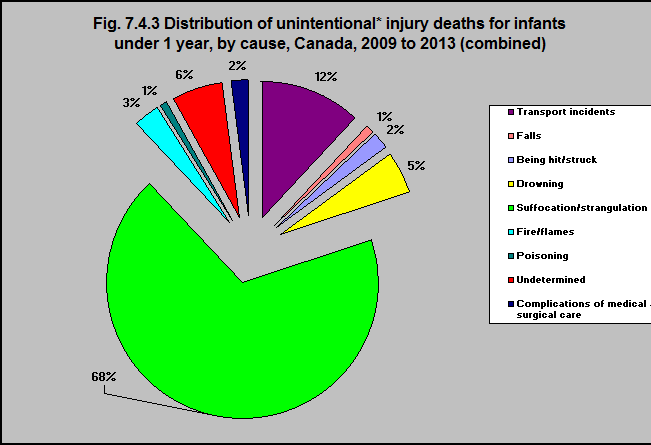Distribution of unintentional injury deaths for infants under 1 year, by cause, Canada, 2009 to 2013 (combined)

Note:
*Unintentional injuries are unplanned events that occur in a short period of time – seconds or minutes- in which the harmful outcome was not sought and was the result of physical energy in the environment or normal body functions being blocked by external means, e.g., drowning. http://www.maine.gov/dhhs/mecdc/population-health/inj/unintentional.html -accessed June 22, 2017.
Source: CICH graphic created using data adapted from Statistics Canada. Table 102-0540 – Deaths, by cause, Chapter XX: External causes of morbidity and mortality (V01 to Y89), age group and sex, Canada, annual (number). http://www5.statcan.gc.ca/cansim/a26?lang=eng&retrLang=eng&id=1020540&&pattern=&stByVal=1&p1=1&p2=-1&tabMode=dataTable&csid= – accessed June 22, 2017.
In the combined years 2009 to 2013, the most common cause of unintentional injury deaths among infants under a year was suffocation or strangulation – two-thirds of the deaths were due to this cause.
The next most common cause of unintentional injury death among infants under a year was transport incidents followed by drowning.
Implications
Ensure children have safe sleeping environments.
One of the most effective strategies to prevent infants from suffocating is to ensure that they are sleeping in cribs or cradles that meet current regulations.1 In addition, they should not sleep with soft comforters, pillows, crib bumpers, stuffed animals – or other things that they could suffocate.2 Infants should always be placed on their backs to sleep and young children should sleep in cribs or cradles that were built after 1986.
1Parachute. Choking. http://www.parachutecanada.org/injury-topics/item/choking -accessed June 21, 2017.
2Nakamura S, Wind M, Danello MA. Review of hazards associated with children placed in adult beds. Archives of Pediatric and Adolescent Medicine. 1999;153:1019–1023.
